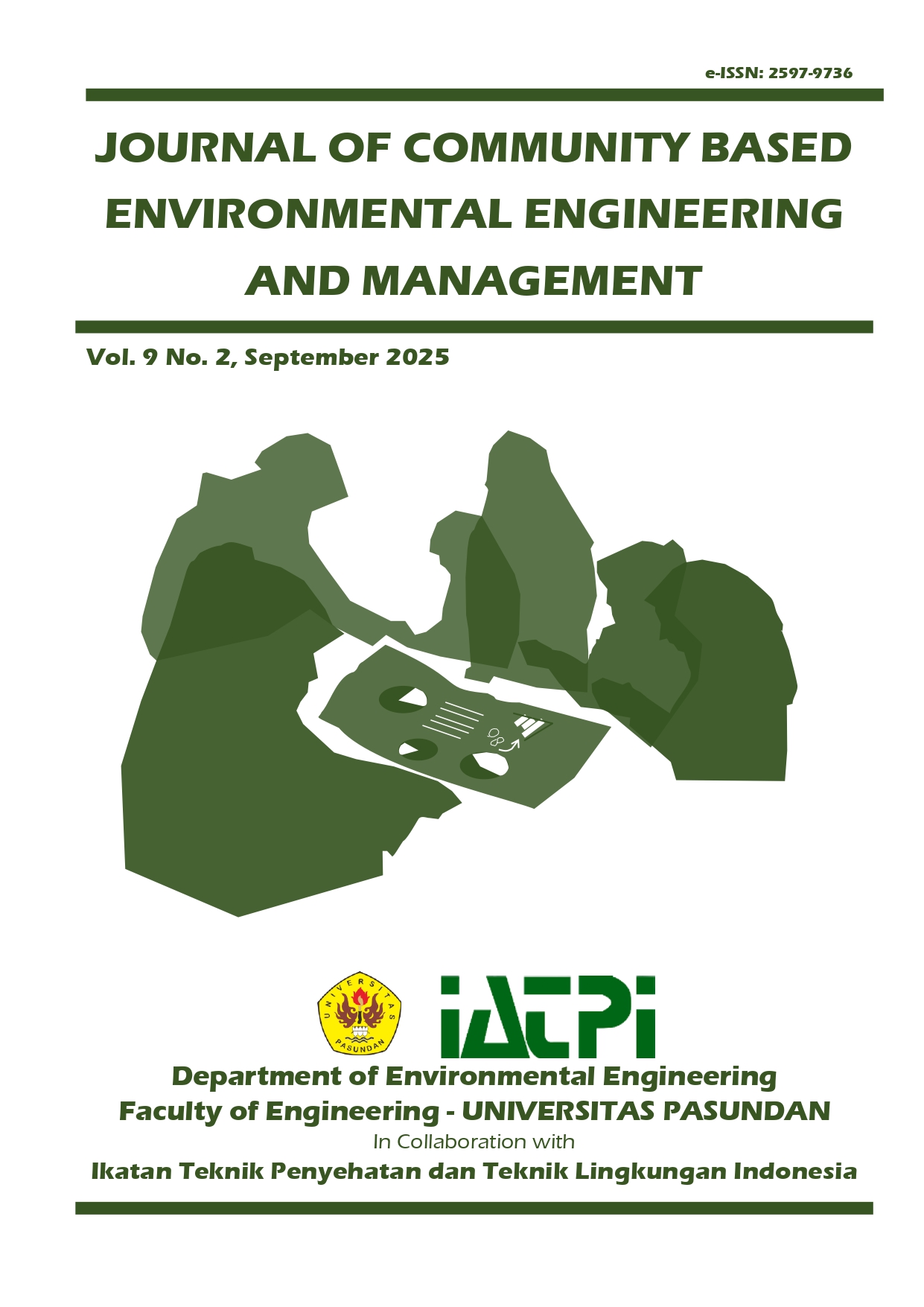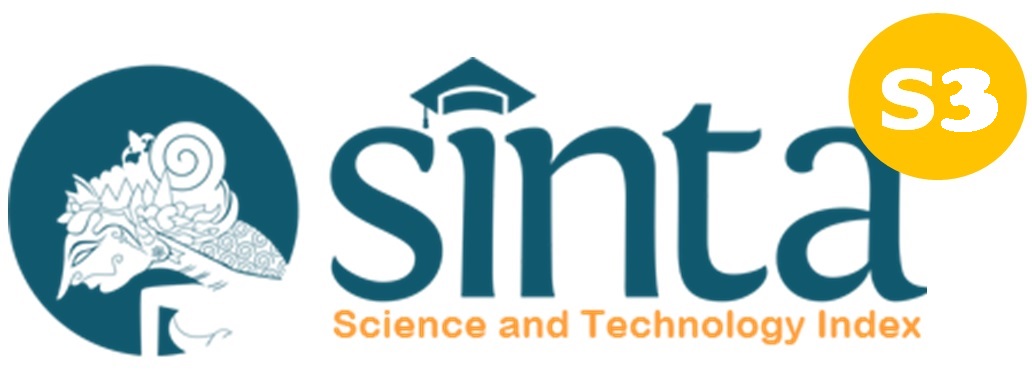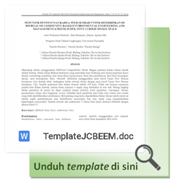Evaluation of Drinking Water Treatment Plant Design at Badan Layanan Umum Daerah (BLUD) Drinking Water Treatment Plant
DOI:
https://doi.org/10.23969/jcbeem.v9i2.30219Keywords:
drinking water, water treatment plant, water quality, treatment process, design evaluationAbstract
This study evaluated the performance of the BLUD Drinking Water Treatment Plant (WTP) in Cimahi to identify parameters exceeding national standards and assess design and operational adequacy. Raw water quality did not comply with PP No. 22/2021 for BOD (11.9 mg/L), COD (24.1 mg/L), detergent (0.426 mg/L), fecal coliform (4.27 × 10⁷ MPN/100 mL), total coliform (1.14 × 10⁶ MPN/100 mL), nitrite (0.093 mg/L), sulfate (0.328 mg/L), TSS (88 mg/L), and zinc (0.061 mg/L). Treated water failed Permenkes No. 2/2023 for color (22.5 TCU) and residual chlorine (0.16 mg/L), while negative removals were observed for fluoride, manganese, nitrite, TDS, and color. Evaluation revealed several design flaws: bar screen spacing of 25 mm and thickness of 10 mm (required 4–8 mm and 25–50 mm); coagulation with constant PAC dosing (18 mg/L) without jar testing; flocculation detention time of 22 min with constant velocity gradients (30.5 s⁻¹) instead of 30–45 min with decreasing gradients; sedimentation with detention time of 0.97 h and surface loading of 3.75 m³/m²·h (required 1.5–3 h and 3.8–7.5 m³/m²·h); filtration with backwash velocity of 41.86 m/h and duration of 5 min (required 46–50 m/h and 10–15 min); and disinfection with velocity gradient of 111 s⁻¹ (required ~500 s⁻¹). Revised designs included reducing bar spacing to 8 mm and thickness to 50 mm, implementing routine jar testing, extending flocculation detention to 30.1 min with step-down gradients (34–26 s⁻¹), deepening sedimentation basins to 6 m (detention 1.54 h, surface loading 3.87 m³/m²·h), increasing backwash velocity to 46.56 m/h for 10 min, and installing a static mixer (G = 1427 s⁻¹) for chlorine application. These improvements are expected to enhance removal efficiency, eliminate negative removals, and ensure compliance with Indonesian drinking water standards.
Downloads
References
Badan Pusat Statistik Kota Cimahi. (2023). Kota Cimahi dalam angka 2023 (Cimahi Municipality in Figures 2023). Badan Pusat Statistik Kota Cimahi. https://cimahikota.bps.go.id
Badan Standardisasi Nasional. (2008). SNI 6774:2008: Tata cara perencanaan unit paket instalasi pengolahan air. Jakarta: Badan Standardisasi Nasional.
BLUD Air Minum Kota Cimahi. (2023). Tentang Kami. https://bludamcimahi.com/about Accessed 13 July 2025.
Camellia, A., & Marsono, B. D. (2020). Evaluasi kinerja unit filter IPAM Karangpilang III PDAM Surya Sembada Kota Surabaya. Jurnal Teknik ITS, 9(2), C99–C106.
Hamamoto, S., Kishimoto, N., & Ueki, M. (2015). Mechanistic consideration of fluoride removal using aluminum sulfate. Journal of Water and Environment Technology, 13(1), 15–24. https://doi.org/10.2965/jwet.2015.15
Pertiwi, B. N. R., & Sururi, M. R. (2023). Analisis kualitas air baku untuk sumber air minum BLUD Cimahi. Prosiding Seminar Nasional dan Diseminasi Tugas Akhir FTSP 2023, 1–5. Institut Teknologi Nasional Bandung.
Ramadhan, F., Maleiva, L. T. N., & Nugraheni, P. W. (2024). A study of the effects of aluminum sulfate (alum) and poly aluminum chloride (PAC) on the coagulation process of dug well water. Indonesian Journal of Fundamental and Applied Chemistry, 9(1), 55–65. https://doi.org/10.24845/ijfac.v9.i1.55
Ramadhani, N. R., Alim, M. S., Husin, M., & Firdausy, M. A. (2024). Analisis pH, kekeruhan dan jarak air bersih terhadap sisa klor pada jaringan distribusi pelanggan IPA 1 A. Yani PTAM Bandarmasih zona Banjarmasin Barat. JTAM Teknik Lingkungan Universitas Lambung Mangkurat, 7(2), 53–68.
Staddal, I., Haridjaja, O., & Hidayat, Y. (2016). Analisis debit aliran sungai DAS Bila Sulawesi Selatan. Jurnal Sumber Daya Air, 12(2), 117–130.
Turgut, S., Yenisoy, Y., Mohamadi, Y., & Torun, K. (2023). Sizing and structural analysis of mechanical bar screen. In Proceedings of the International Conference on Basic Sciences, Engineering and Technology (ICBASET 2023), (Vol. 22, pp. 268–273). https://doi.org/10.55549/epstem.1350960
World Health Organization, Regional Office for South-East Asia. (2017). Principles and practices of drinking-water chlorination: A guide to strengthening chlorination practices in small- to medium-sized water supplies (p.28). World Health Organization.
Yogafanny, E. (2015). Pengaruh aktifitas warga di sempadan sungai terhadap kualitas air Sungai Winongo. Jurnal Sains dan Teknologi Lingkungan, 7(1), 41–50.
Zaman, N., Nasution, N. H., Iswahyudi, Susilawaty, A., Sitorus, E., Mohamad, E., Rodhiyah, Z., Syam, M. A., Murtini, S., Rois, I., Tangio, J. S., Rudiansyah, & Haryanti, S. (2023). Manajemen kualitas air. Yayasan Kita Menulis.














